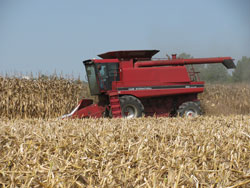Some weather issues over the past month caused USDA to slightly lower the forecast for this year’s corn crop, but it is still expected to be a record at 13.16 billion bushels.
 The average yield was lowered due to average 162.5 bushels per acre, down 2.5 bushels from the previous month and 2.2 bushels below last year’s record of 164.7 bushels. Forecasted yields decreased from last month throughout much of the Corn Belt, Tennessee Valley, and Delta. Yields were up from August in the lower portions of the Southeast.
The average yield was lowered due to average 162.5 bushels per acre, down 2.5 bushels from the previous month and 2.2 bushels below last year’s record of 164.7 bushels. Forecasted yields decreased from last month throughout much of the Corn Belt, Tennessee Valley, and Delta. Yields were up from August in the lower portions of the Southeast.
USDA is also forecasting increased ethanol production and lower ending stocks with higher prices for corn. “We have seen increased demand so we boosted our ethanol production for the current year, which means our ending stocks have gone down a bit,” said USDA Chief Economist Joe Glauber. “We’re now looking at ending stocks of corn of 1.1 billion bushels and a season average price of $4.40 a bushel – that’s a big increase.”
USDA added 35 million bushels to the 2009-10 corn used for ethanol for a total of 4.535 billion bushels to reflect the actual production numbers through August. Outlook Board Chairman Gerry Bange says they also increased the estimate for 2010-11 but not as much as some might expect. “What we’re thinking is that with the current rise in corn prices we’ve seen and with the gasoline price coming off we might expect somewhat of a slow down in the rate of increase for ethanol production, so we’re carrying a number at 4.7 billion bushels for 2010-11, which is up nearly four percent,” said Bange. USDA lowered total 2010/11 corn demand by 50 million bushels.
According to Renewable Fuels Association Vice President of Research Geoff Cooper, the changes in this latest USDA report were expected and speculators have been running up the corn prices lately.
“The recent flurry of activity in the corn market is undoubtedly being driven by the resurgence of speculators. Hedge and index funds are descending on the corn market in numbers not seen since the spectacular commodities bubble of 2008,” Cooper wrote in a blog post on the E-Xchange. “The movements of the market become sufficiently more exaggerated when this many speculators are in the game. The highs are higher, the lows are lower, and everything happens faster.” He notes that the Friday prior to the crop report coming out, a record 556,034 corn futures contracts (the equivalent of 2.8 billion bushels of corn!) changed hands, marking the single busiest day in the corn markets since the Chicago Board of Trade began trading grain in 1877.

